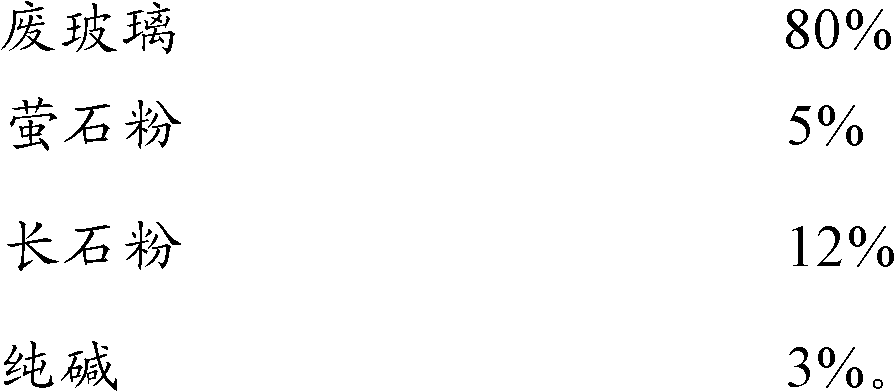Preparation method of colored glass wall brick or glass tile
A technology of colored glass and wall bricks, which is applied in the field of building materials, can solve the problems of unsatisfactory physical and chemical properties, unsatisfactory strength and applicability of fired products, and the inability to be used as glass wall bricks to achieve low cost, High compressive strength, not easy to aging effect
- Summary
- Abstract
- Description
- Claims
- Application Information
AI Technical Summary
Problems solved by technology
Method used
Image
Examples
Embodiment 1
[0027] Mix 800 kg of clean waste glass, 50 kg of fluorspar powder, 120 kg of feldspar powder and 30 kg of soda ash as raw materials, and then add 2 kg of CuO; send the resulting mixture into a continuously operating glass tank kiln. Burn the molten glass at a temperature of 1050-1100°C; send the obtained molten glass into a cast iron drum mold and press it into a hollow brick of the required specification; use a conveyor belt to send the pressed hollow brick into a tunnel annealing kiln, at 400-600 After annealing at a temperature of ℃, it is naturally cooled to obtain the final product.
Embodiment 2
[0029] Mix 950 kg of clean waste glass, 80 kg of fluorite powder, 60 kg of feldspar powder and 22 kg of soda ash as raw materials, and then add 4.5 kg of NiO; send the resulting mixture into a continuously operating glass tank kiln. Burn the molten glass at a temperature of 1050-1100°C; send the obtained molten glass into a cast iron drum mold and press it into a glass tile of the required specification; use a conveyor belt to send the pressed glass tile into a tunnel annealing kiln, at 400 After annealing at -600°C, cool naturally to obtain the final product.
Embodiment 3
[0031] Mix 600 kg of clean waste glass, 40 kg of fluorspar powder, 80 kg of feldspar powder, 50 kg of dolomite and 16 kg of soda ash, and then add 0.79 kg of Cr 2 o 3 ; Send the obtained mixture into the glass tank kiln for continuous operation, and burn it into molten glass at a temperature of 1050-1100°C; send the obtained molten glass into a cast iron drum mold and press it into a hollow brick of the required specification; use a conveyor belt Send the pressed hollow bricks into the tunnel annealing kiln, anneal at a temperature of 400-500°C, and then cool naturally to obtain the final product.
[0032] Adopting the preparation method of the present invention to manufacture glass wall bricks or glass tiles, the compressive strength is high, the raw materials are easy to obtain, the process is simple, the cost is low, the energy consumption is low, continuous production can be realized, and the color of the prepared product is rich, Strong applicability, for example, glass ...
PUM
 Login to View More
Login to View More Abstract
Description
Claims
Application Information
 Login to View More
Login to View More - R&D
- Intellectual Property
- Life Sciences
- Materials
- Tech Scout
- Unparalleled Data Quality
- Higher Quality Content
- 60% Fewer Hallucinations
Browse by: Latest US Patents, China's latest patents, Technical Efficacy Thesaurus, Application Domain, Technology Topic, Popular Technical Reports.
© 2025 PatSnap. All rights reserved.Legal|Privacy policy|Modern Slavery Act Transparency Statement|Sitemap|About US| Contact US: help@patsnap.com



